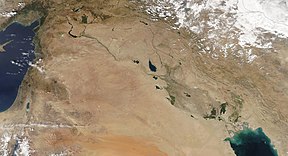
Mesopotamia
Historical region within the Tigris–Euphrates river system / From Wikipedia, the free encyclopedia
Dear Wikiwand AI, let's keep it short by simply answering these key questions:
Can you list the top facts and stats about Mesopotamia?
Summarize this article for a 10 years old
Mesopotamia[lower-alpha 1] is a historical region of West Asia situated within the Tigris–Euphrates river system, in the northern part of the Fertile Crescent. Today, Mesopotamia occupies modern Iraq.[1][2] In the broader sense, the historical region included present-day Iraq and parts of present-day Iran, Kuwait, Syria and Turkey.[3][4]
Part of a series on the |
|---|
| History of Iraq |
 |
|
|
The Sumerians and Akkadians (including Assyrians and Babylonians), each originating from different areas, dominated Mesopotamia from the beginning of recorded history (c. 3100 BC) to the fall of Babylon in 539 BC, when it was conquered by the Achaemenid Empire. Mesopotamia was next conquered by Alexander the Great in 332 BC, and after his death it became part of the Greek Seleucid Empire.
Mesopotamia is the site of the earliest developments of the Neolithic Revolution from around 10,000 BC. It has been identified as having "inspired some of the most important developments in human history, including the invention of the wheel, the planting of the first cereal crops, and the development of cursive script, mathematics, astronomy, and agriculture". It is recognised as the cradle of some of the world's earliest civilizations.[5]
Around 150 BC, Mesopotamia was under the control of the Parthian Empire. It became a battleground between the Romans and Parthians, with western parts of the region coming under ephemeral Roman control. In 226 AD, the eastern regions of Mesopotamia fell to the Sassanid Persians. The division of the region between the Roman (Byzantine Empire from 395 AD) and Sassanid Empires lasted until the 7th century Muslim conquest of Persia of the Sasanian Empire and Muslim conquest of the Levant from Byzantines. A number of primarily neo-Assyrian and Christian native Mesopotamian states existed between the 1st century BC and 3rd century AD, including Adiabene, Osroene, and Hatra.

